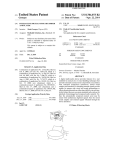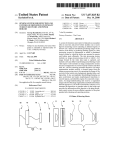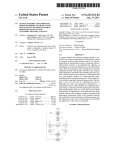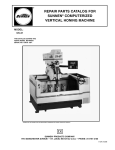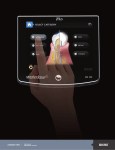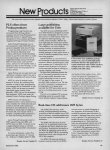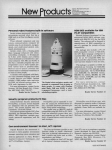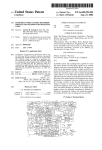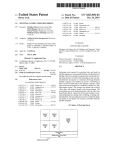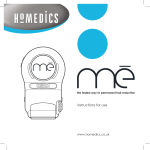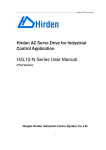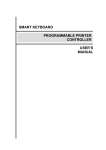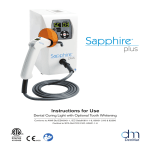Download Dual pulse-width medical laser with presets
Transcript
US007970030B2 (12) United States Patent (10) Patent N0.: Rizoiu et a]. (54) US 7,970,030 B2 (45) Date of Patent: DUAL PULSE-WIDTH MEDICAL LAsER (56) Jun. 28, 2011 References Cited WITH PRESETS U.S. PATENT DOCUMENTS 75 I nvent ors: I 0ana_ M . izoiu, I S an C1 ement e, CA (Us), Dmltl‘l 301113011550", Dana P011“, CA (US) 3,051,905 A 3,051,906 A * 8/1962 Haynes 55/1962 Haynes ,,,,,,,,,,,,,,,,,,,,,,, ,, 327/105 3,515,938 A * 3,578,986 A * 6/1970 5/1971 7/1972 Houldcroft et al. 7/1972 Dahlinger (73) Assignee: Biolase Technology, Inc., Irvine, CA (US) 3,679,863 A 3,679,998 A (*) Notice: Subject to any disclaimer, the term of this 3914548 A patent is extended or adjusted under 35 4,005,333 A 3,711,725 A * . . 3,991,296 A U-S-C- 15403) by 183 days- Filed: DE ( Jun. 4, 2009 Related U 5 Application Data (63) Kojima et a1. M977 Nichols 3840126 A1 5/1990 Continued Prior Publication Data US 2009/0141752 A1 11/1976 FOREIGN PATENT DOCUMENTS Feb. 9, 2009 (65) Johannessen ............... .. 307/108 10/1975 Fniidman et a1‘ (Continued) (21) Appl' NO‘: 12/368’266 (22) 1/1973 Morse .......... .. .. McGuf?n et a1. ........... .. 327/397 Continuation-in-part of application No. 11/ 191,594, ?led on Jul. 27, 2005, noW Pat. No. 7,630,420, Whichis ) OTHER PUBLICATIONS Cook, “Pulse Forming Network Investigation”, Aug. 1975, Thesis at Texas Tech University.* _ (commued) a continuation-in-part of application No. 11/033,032, (60) ?led on Jan. 11, 2005, noW abandoned, Which is a continuation-in-part of application No. 11/203,400, ?led on Aug‘ 12’ 2005’ now abandoned‘ Primary Examinerijessica T Smltz Assistant Examiner i Joshua King (74) Attorney, Agent, or Firm * Stout, Uxa, Buyan & Provisional application No. 60/591,933, ?led on Jul. Mullins, LLP 27, 2004, provisional application No. 60/601,415, (51) Int. C]. A medical laser device is described that generates a laser H01S 3/00 (52) (58) (200601) beam controllable With presets as to pulse duration, pulse us. Cl. .................. .. 372/3804; 372/3806; 372/25; repetition rate, Power and energy Per pulse- The device also 372/30; 372/31; 372/3802; 372/70; 606/10; 606/1 1 provides presets With respect to Water and air outputs. Para metric values for poWer, pulse duration, pulse repetition rate, Field of Classi?cation Search ............. .. 372/3806, 372/3804 25 30 31 3802 70. 606/10 606/11 and energy Per Pulse as Well as for Water and air Settings may be programmed by an end user and stored as presets. See application ?le for complete search history. 100 x 105 2 Hi Voltage Power Supply 20 Claims, 8 Drawing Sheets 165 2 f 170 US 7,970,030 B2 Page 2 US. PATENT DOCUMENTS 4,087,705 4,276,518 4,550,275 4,724,299 4,770,811 4,826,431 4,862,888 4,908,030 4,910,438 4,913,142 4,931,047 4,985,027 5,086,378 5,092,773 5,092,864 5,102,410 5,151,029 5,199,870 5,221,561 5,237,331 5,242,454 5,263,950 5,267,856 5,313,481 5,318,562 5,334,019 5,374,266 5,388,988 5,401,171 5,409,376 5,498,935 5,552,675 5,554,172 5,570,182 5,611,797 5,694,046 5,723,864 5,729,562 5,741,247 5,755,751 5,764,672 5,785,521 5,820,627 5,825,958 5,828,803 5,869,805 6,080,148 6,083,218 6,106,516 6,118,521 6,193,711 6,223,987 6,231,567 6,254,597 6,288,499 6,315,772 6,350,123 6,389,193 6,449,301 6,512,782 6,561,803 6,567,582 6,669,685 6,701,181 6,878,899 5/1978 6/1981 10/1985 2/1988 9/1988 5/1989 9/1989 3/1990 3/1990 4/1990 6/1990 1/1991 2/1992 3/1992 3/1992 4/1992 9/1992 4/1993 6/1993 8/1993 9/1993 11/1993 12/1993 5/1994 6/1994 8/1994 12/1994 2/1995 3/1995 4/1995 3/1996 9/1996 9/1996 10/1996 3/1997 12/1997 3/1998 3/1998 4/1998 5/1998 6/1998 7/1998 10/1998 10/1998 10/1998 2/1999 6/2000 7/2000 8/2000 9/2000 2/2001 5/2001 5/2001 7/2001 9/2001 11/2001 2/2002 5/2002 9/2002 1/2003 5/2003 5/2003 12/2003 3/2004 4/2005 6,902,290 B2 7,097,639 B1 7,415,050 B2 Barnes Ferguson O’Loughlin Hammeke Myers Fujimura et a1. Yessik Linkow et al. Farnsworth Kittrell et al. Broadwin et al. Dressel Prince Levy Hayes et al. Dressel Levy Steiner et al. Flicstein et al. Henderson et al. Gundlach et al. L’Esperance, Jr. Wolbarsht et a1. Cook et al. Levy et al. Goldsmith et al. Kataoka et a1. Goisser et al. Paghdiwala Murphy McMahan et al. Lemelson Horner et al. Nathel et al. George Hillerich et al. Atkinson et a1. Birx et al. RiZoiu et al. Eckhouse Ukita et a1. RiZoiu et al. Rosen et al. Gollihar et a1. Eckhouse 2002/0149324 A1 6/2005 8/2006 8/2008 10/2002 Watts et a1. Almeida RiZoiu et al. RiZoiu et al. 2003/0069567 A1 * 4/2003 2003/0100824 A1 5/2003 Warren et a1. 2003/0227953 A1* 12/2003 Eckhouse et al. ............... .. 606/9 Hsia et a1. ..................... .. 372/53 2005/0137655 A1 6/2005 MacFarland 2005/0143792 A1 6/2005 Jay 2006/0020309 A1 1/2006 Altshuler et al. FOREIGN PATENT DOCUMENTS DE EP EP EP EP EP GB GB JP JP JP JP JP JP WO W0 WO W0 4138468 0181199 0912833 0454312 0454312 9641657 2 023 330 2297610 5945092 5200045 5506601 11511386 200301465 2003070722 9004358 97 07928 9707928 97 45165 A2 A3 A A A A A1 A3 3/1993 5/1986 9/1986 10/1991 10/1991 12/1995 12/1979 8/1996 3/1984 8/1993 9/1993 10/1999 1/2003 3/2003 5/1990 3/1997 3/1997 4/1997 OTHER PUBLICATIONS Cook, “Pulse Forming Network Investigation”, Aug. 1975, Thesis at Texas Tech University.* Supplementary European Search Report, EP 05711358 (PCT/ US2005/000852), mailed Feb. 8, 2010. International Search Report, Jun. 30, 2008, PCT/US08/051963. International Search Report, May 23, 2008, PCT/US08/051967. International Search Report & Written Opinion, Sep. 2, 2005, PCT/ US05/00849. International Search Report & Written Opinion, Jul. 31, 2006, PCT/ US06/00989. International Search Report & Written Opinion, Oct. 25, 2006, PCT/ US05/28891. International Search Report, Dec. 10, 1998, PCT/US98/12357. Beyer et a1. Written Opinion, Apr. 15, 1999, PCT/US98/12357. Damasco et a1. European Search Report, Jun. 6, 2005, EP 05 07 5231. Partial European Search Report, Apr. 6, 2000, EP 98 92 9060. TS. Fahlen, Ef?cient Quarter-Joule KrF Laser with Corona PreloniZation, IEEE Journal of Quantum Electronics, vol. QE-15, No. 5, pp. 311-312. May 5,1979. Bernard Grob, Basic Electronics, Glencoe division of Macmillan/ McGraw-Hill, pp. 690-681. 1989. New LaseriMatter Interaction Concept to Enhance Tissue Cutting Ef?ciency by Ioana M. RiZoiu and Larry G. DeShaZer, published in SPIE col. 2134A Laser-Tissue Interaction V(1994)/ 309. RiZoiu, Ioana and Levy, Guy C. “Ef?ciency of Bone Ablation with an Chou Massengill Jung et a1. Connors et al. Knowles et al. RiZoiu et al. RiZoiu et al. RiZoiu et al. Marchitto et al. RiZoiu et al. Kimmel et al. Wu et al. Hsia et a1. RiZoiu et al. RiZoiu et al. RiZoiu et al. Tang et al. Smart NdzYAG Laser Beam Delivered with a Cooling Spray” SPIE vol. 1882 Laser-Tissue Interaction IV (1993), pp. 316-321. RiZoiu, Ioana and Levy, Guy C. “Morphological Changes of Dentin and Enamel after Ablation with an Experimental Laser System” SPIE vol. 2128, pp. 282-288. * cited by examiner US. Patent Jun. 28, 2011 Sheet 1 of8 US 7,970,030 B2 I 10w PROVIDE FIRST HIGH VOLTAGE OUTPUT FROM HVPS, CAPABLE OF DRIVING FIRST PFN 7 15v" PROVIDE SECOND HIGH VOLTAGE OUTPUT FROM HVPS, CAPABLE OF DRIVING SECOND PFN I 20 v1 PROVIDE LASER PUMPING SOURCE v 25% GENERATE LASER PULSE HAVING FIRST DURATION I GENERATE LASER PULSE HAVING SECOND DURATION I FIG. 1 US. Patent Jun. 28, 2011 Sheet 2 of8 US 7,970,030 B2 170 105 2 175 110 V1 2 1 115 Hi Voltage 101 Power _ 150 Supply V2 140 S 130 135 C2 I 102 l/I E~----.:\::§’-;--..l5 141f' ' -?_ L2 180 P (a) time p (b) time FIG. 3 time US. Patent Jun. 28, 2011 Sheet 3 of8 US 7,970,030 B2 US. Patent Jun. 28, 2011 Sheet 4 of8 US 7,970,030 B2 US. Patent Jun. 28, 2011 Sheet 5 of8 US 7,970,030 B2 US. Patent Jun. 28, 2011 50O~I~I Sheet 6 of8 START US 7,970,030 B2 I V 505 v4 SELECT PRESET NUMBER V 510 w ENTER POWER SETTING ‘ 513 ENTER PULSE DURATION 515 ENTER REPETITION RATE \ V 520 A ENTER PULSE ENERGY v 525 w ENTER WATER SETTING V 530 w ENTER AIR SETTING I PRESS AND HOLD BUTTON 535 ” FOR SELECTED PRESET 545 I 54o , CONTINUE ‘ " TO HOLD , AUDIBLE INDICATION 550 MORE PRESET-S ? No 555 FIG. 8 US. Patent Jun. 28, 2011 Sheet 8 of8 US 7,970,030 B2 I 810 w PREPARE ACCESS TO PULP CHAMBER USING G6 TIP AND PRESETS FOR CUTTING ENAMEL AND DENTIN I 820 v" REMOVE CORONAL PORTION OF INFECTED! NECTOTIC PULP USING G6 FIBER TIP I 830 w PERFORM INITIAL INSTRUMENTATION v 840 w PERFORM LASER ROOT CANAL ENLARGEMENT \ 850 #- MEASURE WORKING LENGTH I ENLARGE ROOT CANAL USING Z2 FIBER TIP V 870 w ENLARGE ROOT CANAL USING Z3 FIBER TIP V 880 w ENLARGE ROOT CANAL USING Z4 FIBER TIP I FIG. 10 US 7,970,030 B2 1 2 DUAL PULSE-WIDTH MEDICAL LASER WITH PRESETS healing When tissue is brought together. The second effect can be particularly important or relevant, for example, in grafting applications. CROSS-REFERENCE TO RELATED APPLICATIONS Prior art methods of generating these ?rst and second effects can include employing distinctly different devices for each type of tissue cutting. Some prior art methods of per forming ?rst and second effect procedures may include This application is a continuation-in-part of US. applica tion Ser. No. 11/191,594, ?led Jul. 27, 2005 now US. Pat. No. 7,630,420 and entitled DUAL PULSE-WIDTH MEDICAL LASER, the entire contents of Which are incorporated herein employing systems capable of generating different Wave lengths of electromagnetic energy. For example, Wavelengths of about 1 pm and about 3 pm may be generated using CO2 and Erbium type lasers, respectively. Overhead time and effort that may be required in sWitching betWeen tWo medical by reference. US. application Ser. No. 1 1/ 191,594 claims the bene?t of US. Provisional Application No. 60/591 ,933, ?led Jul. 27, 2004 and entitled DUAL PULSE-WIDTH MEDI CAL LASER, the entire contents of Which are incorporated herein by reference. US. application Ser. No. 11/191,594 is a devices can be disadvantages of this approach. Extra time and attendant discomfort from a point of vieW of a patient under going such procedures may represent additional disadvan tages. continuation-in-part of US. application Ser. No. 1 1/033,032, ?led Jan. 11, 2005 noW abandoned and entitled ELECTRO MAGNETIC ENERGY DISTRIBUTIONS FOR ELEC TROMAGNETICALLY INDUCED DISRUPTIVE CUT TING, the entire contents of Which are incorporated herein by reference. This application is also a continuation-in-part of US. application Ser. No. 1 1/ 203,400, ?ledAug. 12,2005 noW A need exists in the prior art for laser devices capable of rapidly and ef?ciently transitioning betWeen varying charac 20 facilitating both hemostatic-type and bleeding-type tissue cutting effects abandoned and entitled DUAL PULSE-WIDTH MEDICAL LASER WITH PRESETS, the entire contents of Which are incorporated herein by reference. US. application Ser. No. 1 1/203,400 claims the bene?t of US. Provisional Application No. 60/601,415, ?led Aug. 13, 2004 and entitled DUAL PULSE-WIDTH MEDICAL LASER WITH PRESETS, the entire contents of Which are incorporated herein by reference. US. application Ser. No. 11/203,400 is a continuation-in-part of US. application Ser. No. 11/033,032, ?led Jan. 11, 2005 25 30 noW abandoned and entitled ELECTROMAGNETIC ENERGY DISTRIBUTIONS FOR ELECTROMAGNETI CALLY INDUCED DISRUPTIVE CUTTING, the entire contents of Which are incorporated herein by reference. SUMMARY OF THE INVENTION An exemplary implementation of the method present invention addresses these needs by providing ?rst and second high voltage outputs from a single poWer supply. A laser pumping source (e.g., a ?ashlamp) also can be provided, the laser-pumping source being capable of exciting a laser that may be used for cutting tissue. The ?rst and second high voltage outputs drive respective ?rst and second pulse-form ing netWorks capable of generating respective ?rst and sec 35 BACKGROUND OF THE INVENTION ond pulse outputs that pump the laser-pumping source according to the exemplary implementation of the method. Pulses produced by the ?rst pulse-forming netWork may be relatively short, and pulses produced by the second pulse forming netWork may be relatively long. 1. Field of the Invention The present invention relates generally to electromagnetic energy emitting devices and, more particularly, to pulsed teristics or modes of operation, to facilitate, for example, different desired cutting effects or procedures such as for 40 Another embodiment of the present invention comprises an electromagnetic energy emitting device, Which, according to medical treatment laser devices. an exemplary embodiment, may comprise a medical laser 2. Description of Related Art device, Wherein the electromagnetic energy-emitting device is capable of emitting a sequence of electromagnetic pulses A variety of electromagnetic energy generating architec tures have existed in the prior art. A solid-state laser system, 45 for example, generally comprises a laser rod for emitting coherent light and a source for stimulating the laser rod to emit the coherent light. Flashlamps are typically used as stimulation sources for middle infrared lasers betWeen 2.5 microns (um) and 3.5 pm, such as Er, Cr:YSGG and Er:YAG 50 having ?rst durations and second durations, Wherein the elec tromagnetic energy-emitting device is adapted to store pre sets specifying combinations of electromagnetic pulses hav ing ?rst durations and second durations and Wherein the apparatus is capable of cutting tissue. One embodiment of the medical electromagnetic energy device can comprise a con troller capable of storing presets, Which may include param eters that control operation of the medical electromagnetic laser systems. The ?ashlamp is driven by a ?ashlamp current, Which comprises a predetermined pulse shape and a prede termined frequency. energy device. Examples of parameters that may be stored as The ?ashlamp current drives the ?ashlamp at the predeter mined frequency, to thereby produce an output ?ashlamp light distribution having substantially the same frequency as the ?ashlamp current. This output ?ashlamp light distribution from the ?ashlamp drives the laser rod to produce coherent light at substantially the same predetermined frequency as the ?ashlamp current. Medical applications, such as those requiring the excision presets can include poWer, pulse duration, pulse repetition 55 device can include a user input panel through Which a user can modify and save presets. While the apparatus and method has or Will be described 60 of soft human tissue, may in some instances require or bene?t from tWo opposite tissue effects. The ?rst effect may relate to laser cutting of tissue With controlled hemostasis, minimal to no bleeding, and attenuated or eliminated charring of cut surfaces. The second effect may relate to laser cutting With bleeding in order, for example, to stimulate post-operative rate, energy per pulse, a Water setting, and an air setting. Another embodiment of the medical electromagnetic energy 65 for the sake of grammatical ?uidity With functional explana tions, it is to be expressly understood that the claims, unless expressly formulated under 35 U.S.C. 112, are not to be construed as necessarily limited in any Way by the construc tion of “means” or “steps” limitations, but are to be accorded the full scope of the meaning and equivalents of the de?nition provided by the claims under the judicial doctrine of equiva lents, and in the case Where the claims are expressly formu US 7,970,030 B2 3 4 lated under 35 U.S.C. 112 are to be accorded full statutory Although the disclosure herein refers to certain illustrated embodiments, it is to be understood that these embodiments are presented by Way of example and not by Way of limitation. equivalents under 35 U.S.C. 112. Any feature or combination of features described herein are included Within the scope of the present invention pro vided that the features included in any such combination are not mutually inconsistent as Will be apparent from the con The intent of the folloWing detailed description, although discussing exemplary embodiments, is to be construed to text, this speci?cation, and the knowledge of one skilled in the art. For purposes of summarizing the present invention, cer tain aspects, advantages and novel features of the present embodiments as may fall Within the spirit and scope of the invention as de?ned by the appended claims. It is to be under stood and appreciated that the process steps and structures cover all modi?cations, alternatives, and equivalents of the described herein do not cover a complete architecture and invention are described herein. Of course, it is to be under process How for operation of electromagnetic energy (e.g., laser) devices. The present invention may be practiced in stood that not necessarily all such aspects, advantages or features Will be embodied in any particular embodiment of the present invention. Additional advantages and aspects of the present invention are apparent in the folloWing detailed description and claims that folloW. conjunction With various structures and techniques that are conventionally used in the art, and only so much of the com monly practiced items are included herein as are necessary to provide an understanding of the present invention. The present invention has applicability in the ?eld of electromag BRIEF DESCRIPTION OF THE FIGURES netic treatment devices in general. For illustrative purposes, hoWever, the folloWing description pertains to a medical laser FIG. 1 is a How diagram describing an implementation of the method of the present invention; FIG. 2 is a schematic diagram illustrating an embodiment of a dual pulse-Width ?ashlamp driving circuit according to the present invention; FIG. 3 is a plot depicting short, long, and mixed electro 20 device and a method of operating the medical laser device to perform tissue treatments and surgical functions. Referring more particularly to the draWings, FIG. 1 is a 25 magnetic energy pulses generated by the dual pulse-Width How diagram describing an implementation of the method of the present invention. This implementation of the method provides a ?rst high voltage output from a high voltage poWer FIG. 5 is a partial cut-aWay diagram of a handpiece tip in accordance With an exemplary implementation of the present supply (HVPS) at step 10. The ?rst high voltage output is capable of driving a ?rst pulse-forming netWork (PFN). A second high voltage output from the HVPS is provided at step 15. The second high voltage output is capable of driving a second pulse-forming netWork. An exemplary embodiment of the high voltage outputs described herein can provide about 1500 volts from the ?rst high voltage output and about 500 volts from the second high voltage output. A pumping invention; source, such as a laser-pumping source, is further provided at ?ashlamp driving circuit shoWn in FIG. 2 in accordance With various aspects of the present invention; FIG. 4 is a pictorial diagram of a delivery system capable of transmitting electromagnetic energy to a treatment site in according to an exemplary embodiment the present invention. 30 FIG. 5a is a detailed illustration of an embodiment of a 35 step 20 according to the implementation. In a representative chamber for mixing spray air and spray Water in the hand embodiment, the laser-pumping source can comprise a piece tip of FIG. 5; ?ashlamp capable of stimulating emission of coherent light FIG. 6 is a cross-sectional vieW of the handpiece tip of FIG. 4 taken along line 6-6' in accordance With an aspect of the by a laser device such as, for example, an ErzYSGG or Er, present invention; CrzYSGG solid state laser. At step 25 of the implementation, 40 duration (i.e., Width) is generated by pumping the laser FIG. 7 is a cross-sectional diagram of a handpiece tip taken along line 7-7' in FIG. 4 according to another aspect of the present invention; FIG. 8 is a How diagram summarizing an implementation of a method of modifying and saving speci?ed values as 45 presets in accordance With the present invention; FIG. 9 is a block diagram of an embodiment of a medical electromagnetic energy controller capable of modifying and saving presets according to the present invention; and FIG. 10 is a How diagram outlining a root canal clinical protocol Wherein presets may be used in accordance With an an electromagnetic energy (e.g., laser) pulse having a ?rst 50 exemplary implementation of the present invention. pumping source With the ?rst pulse-forming netWork output. Similarly, at step 30 a laser pulse having a second duration may be generated by pumping the laser-pumping source With the second pulse-forming netWork output. An example of a circuit capable of driving a ?ashlamp from ?rst and second high voltage outputs is described beloW With reference to FIG. 2. A relatively detailed implementation of the circuit of FIG. 2 is disclosed in FIGS. 2p and 3p of US. Provisional Application No. 60/591,933, ?led Jul. 27, 2004 and entitled DUAL PULSE-WIDTH MEDICAL LASER, the entire contents of Which are incorporated herein by reference to the extent compatible or modi?able by one skilled in the art DETAILED DESCRIPTION OF THE INVENTION 55 to be compatible With any aspect or modi?ed aspect of the present invention. An ErzYSGG or Er, CrzYSGG solid state Reference Will noW be made in detail to the presently laser, Which is capable of generating electromagnetic energy preferred embodiments of the invention, examples of Which having a Wavelength in a range of about 2.70 microns (um) to 2.80 pm, typically 2.78 pm, may be driven With the architec ture of this circuit. Parameters of the ?rst and second pulse are illustrated in the accompanying draWings. Wherever pos sible, the same or similar reference numbers are used in the draWings and the description to refer to the same or like parts. It should be noted that the draWings are in simpli?ed form and are not to precise scale. In reference to the disclosure herein, for purposes of convenience and clarity only, directional terms, such as, top, bottom, left, right, up, doWn, over, above, beloW, beneath, rear, and front, are used With respect to the accompanying draWings. Such directional terms should not be construed to limit the scope of the invention in any manner. 60 forming netWorks may be adjusted to produce, respectively, pulses having relatively short and long durations. In a typical embodiment, relatively short pulses having durations of, for example, about 140 microseconds (us) are produced by the ?rst pulse-forming netWork, and relatively long pulses having 65 durations of, for example, about 400 us are produced by the second pulse-forming netWork. Repetition rates for the pulses may range, for example, from about 1 to 50 pulses/second. US 7,970,030 B2 6 5 operation of the illustrated embodiment. A user input 170, A partial schematic diagram of an embodiment of a dual pulse-Width analog ?ashlamp driving circuit 100 according to Which may comprise, for example, a sWitch on a electromag the present invention is shoWn in FIG. 2, comprising a high netic energy housing or handset (not shoWn), may specify parameters (e.g., user adjustable parameters) such as pulse voltage poWer supply 105 capable of producing dual, i.e., respective ?rst and second, high voltage outputs 110 and 130 trated embodiment of the dual pulse-Width analog ?ashlamp driving circuit 100 further comprises a ?rst pulse-forming duration and/ or pulse repetition rate. In certain embodiments, additional sWitching transistors 121 and 141, shoWn in phan tom in FIG. 2, may be provided in order to increase current capacity of the ?rst and second pulse-forming netWorks 101 network 101 and a second pulse-forming network 102 con and 102. using methods knoWn to those skilled in the art. The illus nected to respective ?rst and second high voltage outputs 110 A relatively short current pulse 175 may be produced by and 130. First and second pulse-forming netWorks 101 and the ?rst pulse-forming netWork 101 in the embodiment of the 102 are further connected to a ?ashlamp 150 that may func tion as a pumping source for a laser (not shoWn). trated in FIG. 2. The second pulse-forming netWork 102 may The ?rst pulse-forming netWork 101 in the illustrated embodiment comprises a ?rst capacitor 115, a ?rst sWitching transistor 120, (for example, an insulated gate bipolar tran sistor (IGBT)), and a ?rst inductor 125. The ?rst capacitor 115 is connected betWeen the ?rst high voltage output 110 and ground. The ?rst high voltage output 110 further is con nected to the ?rst inductor 125 through the ?rst sWitching transistor 120, and the ?ashlamp 150 is electrically connected betWeen the ?rst inductor 125 and ground. The ?rst pulse forming netWork 101 and the second pulse-forming netWork dual pulse-Width analog ?ashlamp driving circuit 100 illus produce a relatively long current pulse 180 With parameters chosen substantially as described herein. FIG. 3 is a chart illustrating three exemplary chains (a, b, c) of electromagnetic energy pulses capable of being produced 20 long pulses. Chain (b) illustrates relatively short pulses of electromagnetic energy, such as laser energy, and chain (c) 102 may be similar in form to a circuit such as that shoWn in FIG. 3 of the above-referenced US. application Ser. No. l l/033,032 entitled ELECTROMAGNETIC ENERGY DIS TRIBUTIONS FOR by an electromagnetic energy (e.g., laser) device driven by a dual pulse-Width circuit according to the present invention, such as a dual pulse-Width analog ?ashlamp driving circuit 100 shoWn in FIG. 2. Chain (a) illustrates electromagnetic energy, such as laser energy, generated according to relatively 25 depicts a mixture of relatively long and short pulses. An end user, such as a dentist or physician, as distinguished from a ELECTROMAGNETICALLY manufacturer or technician, may select a type of pulse chain INDUCED MECHANICAL CUTTING. The second pulse forming netWork 102, Which is similar in form to the ?rst to be produced using, for example, a user input 170 (FIG. 2). pulse-forming netWork 101, comprises a second capacitor Long pulses generated by the embodiment illustrated in 30 135, a second sWitching transistor 140, and a second inductor 145. The second high voltage output 130 is applied to a terminal of the second capacitor 135, Which has another ter minal connected to ground. The second high voltage output 130 also is coupled through a second sWitching transistor 140 surface. Conversely, short pulses generated by the same embodiment may provide for cutting With bleeding in order to 35 to the second inductor 145, Which is connected to the ?ashlamp 150. In typical embodiments of the dual pulse-Width analog ?ashlamp driving circuit 100, ?rst and second capacitors 115 and 135 may assume values of, respectively, about 30 micro 40 45 INDUCED MECHANICAL CUTTING. According to cer tain implementations of the present invention, use of the methods and apparatus described herein are not restricted to medical (or dental) applications alone, and similar methods and apparatus contemplated by the present invention may be per second (J/s). The second high voltage output 130 in the 50 volts at an impedance level capable of charging the second capacitor 135 at a rate of about 1 .I/ s. The ?rst inductor 125 may comprise an inductance of about 30 microhenries (pH) to applied in industrial applications, such as for removing and shaping semiconductor materials. FIG. 4 is a pictorial diagram of a delivery system capable of transferring electromagnetic (e.g., laser) energy to a treat ment site. The illustrated embodiment comprises an electro about 70 pH, such as a solid core inductor having a rated inductance of about 50 pH in an exemplary embodiment. The second inductor 145 may comprise an inductance of about and to perform thermal modi?cations. Examples of long pulse and short pulse applications are described in, for example, the above-referenced US. Provisional Application No. 60/ 601,41 5 entitled DUAL PULSE-WIDTH MEDICAL LASER WITH PRESETS and US. application Ser. No. l l/ 033,032 entitled ELECTROMAGNETIC ENERGY DIS TRIBUTIONS FOR ELECTROMAGNETICALLY illustrative embodiment has a value ranging from about 1200 volts to about 1500 volts at an impedance level capable of charging the ?rst capacitor 115 at a rate of about 1500 Joules embodiment may range from about 200 volts to about 500 promote post-operative healing. In another application, short pulses may be employed in the cutting of hard tissue (e.g., tooth enamel, dentin, bone) While long pulses may be used in cutting soft tissue (e.g., periodontal, mucosa, liver, kidney) farads (uF) to about 70 HF, With an exemplary value being about 50 HF, and about 300 uF to about 600 uF, With an exemplary value being about 400 uF. First and second capaci tors may receive respective ?rst and second high voltage outputs 110 and 130. The ?rst high voltage output 110 in an FIG. 2 may be used to achieve an objective of cutting tissue With good hemostasis, no bleeding, and no charring of a cut 55 800 pH to about 1200 uH, such as a solid core inductor having magnetic energy (e.g., laser) handpiece 220 that connects to an electromagnetic energy (e.g., laser) base unit 230 using a linking element 225. The linking element 225 may comprise an inductance of about 1 millihenry (mH). The ?ashlamp 150 a conduit 235, Which may include one or more electromag may comprise a 450 to 900 torr source, such as a 700 torr netic energy (e.g., laser) conduits or ?bers, tubing for air, tubing for Water, and the like. The linking element 225 further source. Control signals 155 and 160 from a control device 165 may be applied to terminals of transistors 120 and 140 in order to enable operation of the ?rst pulse-forming netWork 101 or the second pulse-forming netWork 102. Enabling the ?rst pulse-forming netWork 101 may generate relatively short electromagnetic energy pulses, and enabling the second pulse-forming netWork 102 may generate relatively long electromagnetic energy pulses according to a typical mode of 60 may comprise a connector 240 that joins the conduit 235 to the electromagnetic energy base unit 230. The connector 240 may be an identi?cation connector as is described more fully in US. application Ser. No. ll/l92,334, ?led Jul. 27, 2005 65 and entitled IDENTIFICATION CONNECTOR FOR A MEDICAL LASER HANDPIECE, the entire contents of Which are incorporated herein by reference to the extent com US 7,970,030 B2 7 8 patible or modi?able by one skilled in the art to be compatible With any aspect or modi?ed aspect of the present invention. Waveguides 325. The re?ected light, including the ?rst por tion 330, may be received by second mirror 320, Which directs the re?ected light to feedback ?bers 405 (FIG. 6) disposed in an interior of the handpiece tip 245. The feedback The electromagnetic energy handpiece 20 may comprise an elongate portion 222 and a handpiece tip 245, the elongate portion 222 having disposed therein a plurality of optical ?bers 405 may transmit the re?ected light to the electromag netic energy base unit 230 Where the re?ected light can be ?bers that may connect to, or that are the same as, the optical ?bers included in the conduit 235. A proximal (i.e., relatively nearer to the electromagnetic energy base unit 230) portion 221 and a distal (i.e., relatively further from the electromag netic energy base unit 230) portion 250 may be disposed at analyZed as is described, for example, in US. application Ser. No. 11/203,677, ?led Aug. 12, 2005 and entitled LASER HANDPIECE ARCHITECTURE AND METHODS and US. application Ser. No. 11/203,399, ?ledAug. 12,2005 and respective proximal and distal ends of the electromagnetic energy handpiece 220. The distal portion 250 has protruding entitled CARIES DETECTION USING TIMING DIFFER ENTIALS BETWEEN EXCITATION AND RETURN PULSES, the entire contents of both Which are incorporated therefrom an output ?ber tip 255 that is described beloW in more detail With reference to FIG. 5. As illustrated, the link ing element 225 has a ?rst end 226 and a second end 227. First end 226 couples to a receptacle 232 of the electromagnetic energy base unit 230. Second end 227 couples to the proximal herein by reference to the extent compatible or modi?able by one skilled in the art to be compatible With any aspect or modi?ed aspect of the present invention. FIG. 7 is a cross-sectional diagram taken through a housing portion 335 of the electromagnetic energy handpiece tip 245 portion 221 of the electromagnetic energy handpiece 220. The connector 240 may connect mechanically to the electro magnetic energy base unit 230 With a threaded connection to the receptacle 232. FIG. 5 is a partial cut-aWay diagram of a handpiece tip 245 (cf. FIG. 4) that couples With the electromagnetic energy base unit 230 through the linking element 225 and the elongate portion 222 of the electromagnetic energy handpiece 220. of FIG. 5. The illustrated embodiment depicts an output ?ber 20 tip 255 surrounded by a tip ferrule or sleeve 345, and, option ally, glue that ?lls a cavity 350 around the output ?ber tip 255 to hold the output ?ber tip 255 in place. The housing portion 335 may comprise tip Waveguides 325 circularly disposed 25 about the output ?ber tip 255 that may receive illumination light from the second mirror 320 (FIG. 5) and direct the illumination light to a target as described above. In certain The illustrated embodiment, Which is enclosed by an outer surface 246, may receive poWer or treatment electromagnetic embodiments, a plurality of ?uid outputs 380 may be dis (e.g., laser) energy from the electromagnetic energy base unit posed in the housing portion 335 of the handpiece tip 245, the 230. Typically, the treatment electromagnetic energy is trans mitted through a Waveguide, such as treatment ?ber 300, ?uid outputs 380 being con?gured to direct, for example, a 30 disposed in the elongate portion 222 and the handpiece tip 245 as described beloW With reference to FIG. 6.According to one embodiment, treatment electromagnetic energy 305 is received by an internal Waveguide, such as treatment ?ber 300, and is directed toWard a ?rst mirror 315 disposed in the mixing spray air and spray Water in the handpiece tip 245 is shoWn in FIG. 5a. As illustrated, the mixing chamber com prises an air intake 370 connected to, for example, tubing (not 35 distal portion 250 of the electromagnetic energy handpiece 220, Whence re?ected electromagnetic energy is directed toWard the output ?ber tip 255. Electromagnetic energy received by the output ?ber tip 255 may be directed toWard a target (e. g., a treatment) surface. The output ?ber tip 255 may be encased in a tip ferrule or sleeve 345 that, together With the 40 60/610,757, ?led Sep. 17, 2004 and entitled, OUTPUT 45 MAGNETIC-ENERGY PROCEDURAL DEVICE, the entire contents of Which are incorporated herein by reference to be compatible With any aspect or modi?ed aspect of the 50 FIG. 6 is a cross-sectional diagram of a portion of an embodiment of the handpiece tip 245, the cross-section being (FIG. 5), Whence the electromagnetic energy is directed toWard a plurality of tip Waveguides 325 (FIG. 5) disposed in intake 375 join, and a spray (e.g., atomiZed) mixture 385 of Water and air may be ejected through a ?uid output 380. The embodiment illustrated in FIG. 7 depicts three ?uid outputs 380. These ?uid outputs may, for example, correspond to, comprise parts of, or comprise substantially all of, any of the ?uid outputs described in US. application Ser. No. 11/042, to the extent compatible or modi?able by one skilled in the art taken along a line 6-6' of FIG. 5. The electromagnetic energy ?ber 300 may carry electromagnetic energy that is directed toWard ?rst mirror 315 as already described. According to another embodiment, additional ?bers, such as illumination ?bers 400, may carry another form of electromagnetic energy, such as visible light, blue light, and the like, Which electro magnetic energy may be directed toWard a second mirror 320 the connector 240 (FIG. 4). The air intake 370 and the Water intake 375, Which may have circular cross-sections about 250 pm in diameter, join at an angle 365 that may approximate 1 100 in a typical embodiment. Mixing may occur or begin to occur in a neighborhood Where the air intake 370 and Water as is described more fully in US. Provisional Application No. present invention. shoWn) that connects to, and receives air from, a spray air connection in the connector 240 (FIG. 2). Similarly, a Water intake 375 may connect to tubing (also not shoWn) that con nects to and receives Water from a spray Water connection in output ?ber tip 255, forms a removable, interchangeable unit ATTACHMENTS CODED FOR USE WITH ELECTRO mixture of air and Water to a target. A detailed illustration of an embodiment of a chamber for 824, ?led Jan. 24, 2005 and entitled ELECTROMAGNETI CALLY INDUCED CUTTER AND METHOD, the entire contents of Which are incorporated herein by reference to the extent compatible or modi?able by one skilled in the art to be compatible With any aspect or modi?ed aspect of the present 55 60 invention. The ?uid outputs 380 may, as illustrated in FIGS. 4 and 7, have a circular cross-section measuring about 350 pm in diameter. One aspect of the present invention, as outlined in User Manual for a Waterlase® All-Tissue Laser for Dentistry (ref erenced herein as “the incorporated Waterlase® User Manual”), the entire contents of Which are incorporated a housing 335 as is more particularly described beloW With herein by reference, includes programmed parameter values reference to FIG. 7. Another implementation of the present invention receives re?ected light from a target surface, a ?rst referred to herein as presets, the presets being applicable to various surgical procedures. Presets may be programmed at a portion 330 of the re?ected light being received from the output ?ber tip 255, and a second portion of the re?ected light (not shoWn) being received from the plurality of tip 65 time of manufacture of a device, in Which case the presets may be referred to as pre-programmed presets. Alternatively or additionally, presets may be generated or modi?ed and US 7,970,030 B2 9 10 stored by an end user. Table 2 of the incorporated Waterlase® User Manual is reproduced herein as Table 1 and includes examples of pre-programmed presets for general hard and soft tissue procedures. entered preset value or values have been stored. Until a beep is heard (e. g., about tWo to three seconds in one embodiment), the end user continues to hold the selected preset button at step 545 and to Wait for the audible indication. After the TABLE 1 audible indication is heard, the implementation continues at step 550 With a decision, Which may be made by the end user, Suggested Presets for General Hard and Soft Tissue Procedures to be stored, then the implementation of the method can as to Whether more presets are to be stored. If more presets are Preset # Procedure 1 2 3 Enamel Cutting Dentin Cutting Soft Tissue PoWer Rep Rate Energy Per pulse Water Setting Air Setting (Watts) (HZ) (mJ) (%) (%) 6.0 4.0 1.5 20 20 20 300 200 75 75 55 7 90 65 11 repeat, commencing at step 505. When, for example, all pre sets have been stored, the implementation of the method terminates at step 555. Presets, once stored, can be recalled, for example, according to a medical procedure to be per formed, by pressing a preset number button on the user inter face according to an illustrative embodiment. Returning to Cutting (thin tissue, Table 1, the percent air setting and the percent Water setting set forth therein may be directed to one or more ?uid outputs small incisions) 4 Soft Tissue 0.75 20 37.5 0 (cf. 380 of FIGS. 5, 5a and 7) at pressures ranging from about 5 pounds per square inch (psi) to about 60 psi and at How rates 11 Coagulation According to exemplary embodiments, a plurality of pre 20 sets (e.g., programmed settings for one or more of poWer, repetition rate, pulse duration, pulse energy, and settings for air and Water as shoWn in Table 1) may be established. Although not shoWn in the table, an aspect of the present invention comprises the inclusion of pulse duration as one of the presets. The plurality of presets may be generated at a time of manufacture and stored in the electromagnetic energy base unit 230 (FIG. 4). In addition to the pre-programmed preset values for general hard and soft tissue procedures set forth in Table 1, combinations of customiZed values of parameters 25 30 can be stored in the electromagnetic energy base unit 230 as neW presets. According to one implementation of the present invention, each preset can store a pulse duration (e.g., a long pulse mode having pulse durations selectable or variable from ranging from about 0.5 liters/minute to about 20 liters/ minute. A liquid (e. g., Water) may be directed to one or more of the ?uid outputs 380 at pressures ranging from about 5 psi to about 60 psi and at How rates ranging from about 2 milli liters (ml)/minute to about 100 ml/minute. In other embodi ments, the air ?oW rate can go as loW as about 0.001 liters/ minute, and/or the liquid ?oW rate can go as loW as about 0.001 ml/minute. In certain implementations, a Water ?oW rate through a Water line disposed in the electromagnetic energy hand piece may be about 84 ml/minute (e.g., 100%), and an air ?oW rate through an air line of the electromagnetic energy handpiece 220 (FIG. 4) may be about 13 liters/minute (e.g., 100%). These values may be understood in reference to such flow rates or to other flow rates suggested in the incor porated Waterlase® User Manual or otherWise knoWn to those skilled in the art in the same context. 35 about 650 to about 1000 us or a short-pulse mode having a In accordance With an aspect of the present invention, the pulse duration of about 140 us), such as a currently-active storing of one or more combinations of values, in Whole or in part, as presets, may enable an end user to sWitch among the pulse duration, as a parameter and further can store one or presets, for example, during an operation thereby permitting more additional parameters from a group including poWer in Watts (W), pulse repetition rate in hertZ (HZ), energy per pulse 40 the end user to quickly and reliably accomplish multiple procedures of a given operation. E?iciency may be increased in millijoules (ml), Water setting (%) and air setting (%). along With accuracy, such as in the context of relatively com FIG. 8 is a How diagram summarizing an implementation of a method of modifying and saving predetermined or pre ferred values as presets. The illustrated implementation com mences at step 500 and can continue by selecting a preset plex operations that implement combinations of short-pulse mode procedures and long-pulse mode procedures. FIG. 9 is a block diagram of an exemplary embodiment of 45 number at step 505 after Which a poWer setting can be entered at step 510. According to one embodiment, a user interface on an electromagnetic energy base unit comprises a plurality of buttons, including preset buttons, and a display, Whereby an end user, as distinguished from a manufacturer or technician, 50 a medical electromagnetic energy (e.g., laser) controller 600 capable of modifying and saving presets according to an aspect of the present invention. The illustrated embodiment, Which may be disposed, for example, in an electromagnetic energy base unit 230 (FIG. 4), comprises a processor 605 (e.g., a microprocessor), Working memory 610, nonvolatile may select a preset by pressing a button associated With the memory 615, permanent memory 625, and a user interface selected preset. A poWer setting, Which may relate, for 685. The embodiment further comprises an electromagnetic energy (e.g., laser) control interface 670, a Water control interface 675, and an air control interface 680. The aforemen example, to an emitted poWer level of an electromagnetic energy (e.g., laser) beam, may be entered by pressing buttons (e.g., poWer up/doWn buttons) on the keypad in a manner 55 more of pulse duration, repetition rate, pulse energy, Water setting, and air setting may be entered at respective steps 513, 515, 520, 525, and 530, for example, by pressing up/doWn buttons corresponding to respective values for pulse duration, repetition rate, pulse energy, Water setting, and air setting. 60 ing, such as laser housing 230 (FIG. 4)), then stores the holding the selected preset button at step 535 While Waiting at step 540 for an audible noti?cation (e.g., a beep) that the (RAM)), the nonvolatile memory 615, the permanent memory 625, and other system elements, such as a clock (not shoWn), may be implemented on a single microcontroller chip as an application-speci?c integrated circuit (ASIC). In After the values (e.g., one or more of the values) have been entered, an embodiment of an electromagnetic energy hous entered preset values in response to an end user pressing and tioned elements of the embodiment are interconnected by a system bus 665 that facilitates communication among the elements. The illustrated embodiment further comprises a user input panel 700. In some embodiments, the processor 605, the Working memory 610 (e.g., random access memory knoWn to those skilled in the art. Similarly, values for one or 65 other embodiments, the electromagnetic energy control inter face 670, the Water control interface 675, the air control interface 680, and user interface 685 further may be imple mented on the same chip. In yet other embodiments, the latter US 7,970,030 B2 11 12 four elements may be implemented on a companion chip to inputs provided by the end user. The user interface control the microcontroller chip. These and other equivalent imple mentations are contemplated by the present invention. instruction sequence 730 further may cause the processor 605 to activate the speaker 735. Referring again to FIG. 8, and With continued reference to The nonvolatile memory 615 may be con?gured to have stored therein presets 620. The illustrated embodiment com FIG. 9, an end user may, for example, modify and store a set of preset values. The end user may select a present number at prises four presets identi?ed as #1, #2, #3, and #4. Default or pre-programmed values for the presets 620 may be stored in step 505 and may press one of the plurality of preset buttons 695 on the user input panel 700. The user interface 685 may receive an input according to the selected preset number on user communication line 690. The user interface 685 further nonvolatile memory 615 at a time of manufacture of the medical electromagnetic energy controller 600. HoWever, because they are stored in nonvolatile memory 615, Which can be altered, values of the presets can be changed under end-user control. Once changed, the stored preset values are retained in the nonvolatile memory 615, Which is capable of maintaining integrity of stored data even in an absence of may communicate With the processor 605 according to the end-user input. The processor 605 may execute the user inter face control instruction sequence 730 that minimally may cause the processor 605 to update content of the function electrical poWer being supplied to the medical electromag display strip 705 and the value display strip 710 according to netic energy controller 600, The permanent memory 625, Which may be programmed at information received from the user interface 685. Similar interactions betWeen the processor 605 and the user input panel 700 may occur according to the user interface control instruction sequence 730 as Will be understood by those skilled in the art. Subsequent to selecting a preset number at step 505, the end user may press the SELECT button 720 on a time of manufacture of an ASIC, for example, may have instruction sequences stored therein that may, When executed by the processor 605, cause the medical electromagnetic energy controller 600 to perform functions according to the present invention. These instruction sequences in the illus 20 the user input panel 700 until, for example, a POWER indi trated embodiment can include an executive instruction cation is observed in the function display strip 705 according sequence 630, an electromagnetic energy (e.g., laser) control to step 510 of FIG. 8. The end user then may enter a poWer instruction sequence 635, a Water control instruction sequence 655, an air control instruction sequence 660, and a user interface control instruction sequence 730. The electro magnetic energy control instruction sequence 635 may, com prise, as examples, a poWer control instruction sequence 640, a pulse duration control instruction sequence 638, a repetition rate control instruction sequence 645, and a pulse energy control instruction sequence 650. The permanent memory 625 in this and other embodiments may have stored therein additional instruction sequences related, for example, to elec tromagnetic energy handpiece functions tangential to or out side of the immediate scope of the present invention. For example, the permanent memory 625 may contain an instruc 25 setting by, for example, observing a numerical value corre sponding to a currently-active poWer setting in the value display strip 710 and pressing the increment button 715 to thereby increase the poWer setting. The end user also may decrease the poWer setting by pressing the decrement button 30 725. In either case, the end user may continue to press the increment button 715 and/or the decrement button 725 until a desired value for poWer is displayed in the value display strip 710. The end user may again press the SELECT button 720 to 35 magnetic energy pulse duration) according to step 513 of FIG. 8. Again, the user interface instruction sequence 730 may cause the processor 605 to present in the value display tion sequence that controls electromagnetic energy pulse shape according to an end-user input as Well as similar types of instruction sequences related to operation of medical elec change the content of the function display strip 705 to, for example, PUL DUR (indication, for example, of an electro 40 strip 710 a value currently stored for electromagnetic energy pulse duration according to the selected preset. The end user tromagnetic energy (e. g., laser) systems. The executive then may adjust the value displayed in the display strip 710 by instruction sequence 630 minimally may cause the processor 605 to schedule and coordinate the aforementioned instruc pressing the increment and decrement buttons 715 and 725 in a manner similar to that already described. The end user may continue to initiate updating of param tion sequences as Well as additional instruction sequences not described herein. According to an exemplary mode of operation, the embodi 45 interface control instruction sequence 730 may cause the ment of FIG. 9 receives an input from an end user, i.e., an end-user input, on a user communication line 690. The user communication line 690 may be connected to the user input panel 700, Which may have disposed thereon a plurality of 50 display strip 705, such as a liquid crystal display (LCD), may shoWn), thereby Waiting for about 2 to 3 seconds after Which 55 user communication line 690, the user interface 685 may communicate information betWeen the user input panel 700 and the processor 605. For example, the processor 605 may execute the user interface control instruction sequence 730 that minimally may cause the processor 605 to update a processor 605 to store updated parameter values in, for example, Working memory 610. When the end user completes updating desired parameter values, the end user may press and hold the selected one of the preset buttons 695. The user interface control instruction sequence 730 may cause the processor 605 to execute a timing instruction sequence (not preset buttons 695, a SELECT button 720, an increment but ton 715, a decrement button 725 and a speaker 735.A function display a function chosen according to the SELECT button 720, and a numerical parameter value may be displayed in a value display strip 710. When an end-user input is received on eter values for selected preset numbers according to, for example, steps 515, 520, 525, and 530 of FIG. 8. The user 60 time interval the user instruction control instruction sequence 730 may cause the processor to move the updated parameter values to nonvolatile memory 615 and to update content of the selected one of the stored presets 620. The user interface control instruction sequence 730 then may cause the proces sor 605 to transmit an audible signal (e.g., a beep) to the speaker 735. display, such as a message presented in the function display Several operations are noW described that involve combi strip 705 and/or a value presented in the value display strip 710, according to the end-user input. In particular, the user nations of short-pulse procedures and long-pulse mode pro interface control instruction sequence 730 further may cause the processor 605 to interact With the user interface 685, for example, to modify and store preset values 620 according to cedures. In many cases, for a given operation, values for some 65 or all parameters (eg poWer, pulse repetition rate, etc.) may be different for short-pulse mode procedure as compared to values for long-pulse mode procedures. Although the opera US 7,970,030 B2 13 14 tions outlined below are described in a context of a cutter, setting (manual or preset) of operating parameters. The same such as a Waterlase® device, operating in distinct short-pulse or subsequent displays may instruct the end user then to (cf. FIG. 3(b)) and long-pulse (cf. FIG. 3(a)) modes at differ perform, for example, laser root canal enlargement at step 840 using a Z2 output ?ber tip. A similar display or displays may ent times, it should be understood that modi?ed, but not necessarily interchangeable, implementations can include instruct the end user to measure Working length using a Z2 long pulses interspersed in short-pulse mode pulse sequences output ?ber tip at step 850 and to enlarge the root canal at step 860 using the Z2 output ?ber tip. At step 870 the end user may be instructed by the same or subsequent displays to enlarge and/or can include short pulses interspersed in long-pulse mode pulse sequences. For example, one or more of the beloW long-pulse mode procedures of a given operation may, as an the root canal using a Z3 output ?ber tip. The same or subse alternative to a long-pulse mode pulse sequence of only long pulses, implement a long-pulse mode pulse sequence com quent displays then may instruct the end user to enlarge the root canal using a Z4 output ?ber tip at step 880. All of the preceding displays further may instruct the end user to use prising a plurality of alternating long and short pulses (cf. FIG. 3(c)). In the examples that folloW, operations that may be appropriate operating parameter settings (e.g., manual or pre set values for electromagnetic energy (e.g., laser) poWer, pulse duration, pulse repetition rate, pulse energy, and set tings for Water and air). implemented using a cutter, such as a Waterlase® device, are elucidated for various operations Wherein short-pulse modes may be used for some procedures of a given operation and long-pulse modes may be used for other procedures of the operation. These examples include modi?cation of root canal Steps 810-880 of the root canal clinical protocol described in FIG. 10 may be performed in Whole or in part With, for surfaces, modi?cation of prepared cavity surfaces, modi?ca tion of root surfaces at or beloW the gum line (including 20 example, a short-pulse mode (Wherein the parameters for modifying a prepared cavity surface to enhance bonding and steps 840-880 may be recalled for the operation using a pre further including desensitiZing or otherWise treating an outer set). A before and/ or after irrigation step (cf. step 9 in Appen dix C of the incorporated Waterlase® User Manual) may include or be preceded by a modi?cation of surfaces (e.g., side-Wall surfaces) of the root canal using, for example, the root surface), and apicoectomy procedures. Modi?cation of Root Canal Surfaces Appendix C of the incorporated Waterlase® User Manual 25 describes a root canal clinical protocol that is abstracted in Waterlase® in long-pulse mode to modify (e.g., close) FIG. 10. Operating parameters for the procedure as delin eated in the incorporated Waterlase® User Manual (e.g., exposed tubule structures or openings. The cutter, Which may comprise, for example, a Waterlase® device, may be set (e. g., poWer, pulse repetition rate, energy per pulse, Water percent age and/or air percentage, and, as another option, pulse dura tion) may be entered manually or may be recalled using a preset, such as a preset presented above in Table 1. In accordance With an aspect of the present invention, a monitor that may form part of the electromagnetic energy base unit 230 (FIG. 4) may instruct use of various output attachments, such as output ?ber tips. According to an exem plary implementation, various output attachments are embodied in the form of output ?ber tips identi?ed as G6, Z2, Z3, and the like. The monitor may instruct use of the various output attachments at varying times in a given operation or procedure. An embodiment of the present invention may 30 by the end user activating a preset, or manually) to a poWer of about 1.5-2 W, a pulse repetition rate of about 30 HZ, an 35 energy per pulse of about 50 m], a Water setting of about 20%, and an air setting of abut 40%. Surfaces of the root canal may then be modi?ed using a protocol similar to that of steps 840-880. For example, Z2, Z3 and/or Z4 output ?ber tips can be successively used for about 5-10 upWard strokes each Wherein, for example, each upWard stroke involves about 5 seconds of lasing and Wherein the doWnWard strokes do not entail lasing. In another embodiment, the long-pulse proce dure may use only a Z4 output ?ber tip, to the exclusion of the 40 include a visual indication of color codes or topography codes indicative of and corresponding to output tips having a color pattern, various attachments being used at various times, as is more fully described in the above-referenced U.S. Provi any of those knoWn to those skilled in the art or suggested in 45 sional Application No. 60/610,757, ?led Sep. 17, 2004, entitled OUTPUT ATTACHMENTS CODED FOR USE WITH ELECTROMAGNETIC-ENERGY PROCEDURAL DEVICE. In the context of implementing part or all of steps 1-8 of the With techniques suggested in the incorporated Waterlase® rated Waterlase® User Manual) or otherWise knoWn to those 50 skilled in the art. After preparation of the cavity, but before ?lling thereof, the prepared cavity surface may be modi?ed to, for example, enhance bonding properties. The cutter (e. g., Waterlase®) may be set (e.g., by the end user activating a 55 chamber at step 810 using a G6 output ?ber tip at a setting (manual or preset) of operating parameters appropriate for preset, or manually), to a poWer of about 2.5-3 W, a pulse repetition rate of about 30 HZ, an energy per pulse of about 80-100 m], a Water setting of about 10-15%, and an air setting of abut 25-30%. Surfaces of the prepared cavity may then be modi?ed using a circular motion covering all bonding sur faces for a time of, for example, 5-15 sec. cutting enamel and dentin. For example, presets #1 and #2 as presented in Table 1 above may be used to prepare access to the pulp chamber. The ?rst display or a subsequent display the incorporated Waterlase® User Manual, may be recalled for the procedure using a preset, or manually), in combination User Manual (c.f. Tables 2-6 and related text of the incorpo root canal clinical protocol described in Appendix C of the incorporated Waterlase® User Manual, Which steps corre spond to steps 810-880 of FIG. 10, a ?rst display on, for example, an electromagnetic energy base unit 230 (FIG. 4) may instruct that the end user prepare access to the pulp Z2 and Z3 output ?ber tips. Modi?cation of Prepared Cavity Surfaces A cavity is ?rst prepared using, for example, a short-pulse mode (Wherein, for example, the parameters, Which may be may instruct that the end user then use the same output ?ber Modi?cation of Outer Root Surfaces at or BeloW Gum Line Outer root surfaces can be modi?ed using a long-pulse tip at step 820 to remove the coronal portion of the infected/ mode to perform at least one of (1) modifying a prepared 60 necrotic pulp at an appropriate setting of operating param cavity surface to enhance bonding and (2) desensitiZing or eters. According to one embodiment, the operating param otherWise treating the outer root surface. Either of these eters may be preset. The same or a subsequent display may instruct that the end user perform initial instrumentation using a Z2 output ?ber tip at step 830 using an appropriate 65 operations can be implemented by setting (e.g., via the end user activating a preset, or manually) the cutter (e.g., Water lase®) to, for example, a poWer of about 3 W, a pulse repeti US 7,970,030 B2 15 16 Apicoectomy Procedures tion rate of about 30-40 HZ, an energy per pulse of about 80-100 m], a Water setting of about 15-20%, and an air setting of about 40%. During cutting of gingival tissue in an apicoectomy proce dure as described in Appendix C of the incorporated Water 1. Modifying a Prepared Cavity Surface to Enhance Bond lase® User Manual, bleeding of the gingival tissue may be attenuated or treated by sWitching to a long-pulse mode (e. g., via the end user activating a preset, or manually), Which, for example, may con?gure the cutter to a poWer of about 1-2 W, a pulse repetition rate of about 40-50 HZ, an energy per pulse of about 20-40 m], a Water setting of about 0%, and an air 1ng For operations on outer root surfaces involving modifying a prepared cavity surface to enhance bonding, if a caries is present, for example, on or just beloW the gum line on the outer root surface, the cutter (e.g., Waterlase®) may be imple setting of about 10-20% and/or to combinations of values as disclosed in Table 4 of the incorporated Waterlase® User Manual. Short-pulse mode procedures as set forth in a section mented to remove the carious tissue in a short-pulse mode. Short-pulse mode parameters generally knoWn to those skilled in the art or suggested by the incorporated Waterlase® of Appendix C discussing apicoectomy procedures may be User Manual may be used. According to an exemplary embodiment, the parameters are recalled for the procedure enabled using presets. With reference to the apicoectomy procedure set forth in Appendix C of the incorporated Water lase® User Manual, as modi?ed by the disclosure herein, other implementations may comprise either of the tWo (i.e., long and short pulse) soft-tissue cutting modes being used or (via a preset, or manually) using techniques suggested in, for example, Tables 2-6 and related text of the incorporated Waterlase® User Manual. After preparation of the cavity on the outer root surface, but before ?lling thereof, the prepared cavity surface may be modi?ed to, for example, enhance bonding properties. The cutter (e.g., Waterlase®) may be set combined in any sequence or proportion to include, for 20 mode cutting, visa versa, and/or treatments using long pulses interspersed in short-pulse mode pulse sequences and/or (e.g., by the end user activating a preset, or manually), to a long-pulse mode and to the settings disclosed in the preceding section entitled Modi?cation of Prepared Cavity Surfaces, and surfaces of the prepared cavity may then be modi?ed using a circular motion covering pertinent bonding surfaces short pulses interspersed in long-pulse mode pulse 25 for an exemplary time of 5-15 seconds. In modi?ed embodi ments, the short-mode and long-mode pulse procedures may be sWapped in time or combined. 2. DesensitiZing or Otherwise Treating the Outer Root Surface For desensitiZing or otherWise treating the outer root sur example, short-pulse mode cutting folloWed by long-pulse sequences. This disclosure canbe extended to other soft tissue procedures, such as frenectomies. As an example of an api coectomy procedure, a ?rst preset can be activated by the end user to facilitate short-pulse mode incising/cutting, folloWed by the end user activating a second preset to facilitate a long-pulse mode treatment Which may induce, for example, 30 reduced-bleeding cutting or coagulation (via lasing the tissue for about 5-10 seconds), Whereby the operation may continue face, to the extent exposed, the output ?ber tip can be posi With additional switches to or betWeen one or more of the tWo tioned and activated about 2-5 millimeters (mm) from the surface (depending on sensitivity). Lasing can be applied using a circular motion, making sure the patient does not feel pain. In a particular example, lasing may be initiated With the output ?ber tip about 5 mm from the surface and, While lasing With a circular motion, the output ?ber tip may be brought (i.e. long-pulse and short-pulse) cutting modes. Corresponding or related structure and methods described 35 Wherein such incorporation includes corresponding or related closer and closer to a distance of about 2-3 mm from the surface While making sure the patient does not feel pain. An 40 s75 output ?ber tip, manufactured by BioLase Technology, Inc., of San Clemente, Calif., may be used, and the lasing To the extent an outer root surface to be treated is not 45 exposed, obstructing gum tissue may be removed in a long pulse mode by setting (e.g., via the end user activating a preset, or manually) the cutter (e.g., Waterlase®) to, for 50 55 incorporated Waterlase® User Manual, (cf. Tables 2-6 and related text), may be recalled for the procedure via a preset, or manually) using techniques knoWn to those skilled in the art in vieW of this disclosure or suggested by the incorporated Waterlase® User Manual (c.f., Tables 2-6 and related text). In modi?ed implementations, in the context of the present pro Nos. 5,741,247; 5,785,521; 5,968,037; 6,086,367; 6,231,567; 6,254,597; 6,288,499; 6,350,123; 6,389,193; 6,544,256; 6,561,803; 6,567,582; 6,610,053; 6,616,447; 6,616,451; 6,669,685; 6,744,790 and 6,821,272. For example, output optical energy distributions from the ?ashlamp 150 of the illustrated embodiment of the present invention may be useful short-pulse mode (Wherein, as With the long-pulse mode implementation, parameters knoWn or apparent to those skilled in the art, in vieW of this disclosure or suggested by the structure (and modi?cations thereof) in the folloWing patents Which may be (i) operable With, (ii) modi?ed by one skilled in the art to be operable With, and/ or (iii) implemented/used With or in combination With any part(s) of, the present invention according to this disclosure, that/those of the patents, and the knoWledge and judgment of one skilled in the art: US. Pat. application time to treat the exposed root surface may be about 30-60 seconds. example, a poWer of about 1-2 W, a pulse repetition rate of about 40-50 HZ, an energy per pulse of about 20-40 m], a Water setting of about 0%, and an air setting of about 10-20%. In another embodiment, the cutter may be implemented in a in the folloWing patents assigned to BioLase Technology, Inc., are incorporated herein by reference in their entireties, for optimiZing or maximiZing a cutting effect of an electro magnetic energy source, such as a laser that is driven by the ?ashlamp 150. The electromagnetic energy output can be directed, for example, into ?uid (e.g., an atomiZed distribu tion of ?uid particles) above a target surface. An apparatus for directing electromagnetic energy into an atomiZed distribu tion of ?uid particles above a target surface is disclosed in the above-referenced US. Pat. No. 5,574,247. The long and/or short pulses can impart large amounts of energy into the ?uid (e.g., atomiZed ?uid particles) Which preferably comprises 60 Water, to thereby expand the ?uid (e.g., ?uid particles) and apply disruptive (e.g., mechanical) cutting forces to the target surface. cedure, either of the tWo modes can be combined in any sequence or proportion to include, for example, long-pulse In vieW of the foregoing, it Will be understood by those mode cutting folloWed by short-pulse mode cutting, visa versa, and/or treatments using long pulses interspersed in short-pulse mode pulse sequences and/or short pulses inter spersed in long-pulse mode pulse sequences. skilled in the art that the methods of the present invention can 65 facilitate operation of electromagnetic energy devices, and in particular examples medical laser devices exhibiting a capa bility of producing laser pulses having a plurality of pulse US 7,970,030 B2 17 18 durations. The above-described embodiments have been pro prises providing a second high voltage output con?gured to generate a second pulse output differing from the ?rst pulse vided by Way of example, and the present invention is not limited to these examples. Multiple variations and modi?ca output in one or more of duration and poWer. tion to the disclosed embodiments Will occur, to the extent not 3. The method as set forth in claim 2, further comprising: mutually exclusive, to those skilled in the art upon consider generating a pulse having a ?rst duration by pumping the pumping source With the ?rst pulse output; and generating a pulse having a second duration by pumping the pumping source With the second pulse output. ation of the foregoing description. For example, a pumping circuit comprising a plurality (e. g., more than tWo) of high voltage outputs and correspond ing pulse-forming netWorks (e.g., for generating three or more outputs of varying pulse Width) is contemplated by the 4. The method as set forth in claim 3, further comprising generating a plurality of pulses by repetitively pumping the present invention. The present invention may be used With or pumping source With the ?rst pulse output. constructed to implement different electromagnetic energy pulse durations and varying amounts of ?uid (e.g., Water streams, sprays or mists) in the context of, for example, 5. The method as set forth in claim 3, further comprising generating a plurality of pulses by repetitively pumping the laser-pumping source With the second pulse output. Erbium-types of lasers, for facilitating, for example, multiple 6. The method as set forth in claim 3, further comprising generating a plurality of pulses, each pulse having one of a treatment or cutting effects such as hemostatic-type and bleeding-type tissue cutting effects. For example, a Wave length of about 3 um and pulse durations of 50 us and 1000 us may be implemented to provide ?rst and second cutting effects as desired. 20 output. The present invention may also be used or constructed With capacitor-charging poWer supplies in the generation of pulses having variable duration, keeping in mind that such modi? 7. The method as set forth in claim 6, further comprising: receiving a control input from an end user; and cations may in some instances present issues such as limited pulse repetition rates, relatively expensive driving circuitry, controlling the generating of pulses according to the con 25 someWhat rectangular rather than bell-shaped current pulse shapes, and relatively numerous, voluminous and/or heavy the generating of a pulse having a ?rst duration comprises generating a pulse having a duration of about 50 micro While the invention has been described in the context of 30 seconds; and the generating of a pulse having a second duration com prises generating a pulse having duration of about 1000 microseconds. 9. The method as set forth in claim 1, Wherein: being constructed for generating pulses of different lengths, are also contemplated. Moreover, While the invention has been described in the context of using a single poWer supply to generate tWo pulse outputs for an electromagnetic energy trol input. 8. The method as set forth in claim 3, Wherein: capacitors. ?rst and second pulse-forming netWorks, it is to be under stood that greater numbers of pulse-forming netWorks, each similar to the ?rst and second pulse-forming networks but ?rst duration generated by pumping the laser-pumping source With the ?rst pulse output and a second duration generated by pumping the laser-pumping source With the second pulse output device, implementations of the present inventionusing the providing of a ?rst high voltage output comprises pro viding a voltage of about 1500 volts; and the providing of a second high voltage output comprises three or more pulse-forming netWorks may comprise a single poWer supply or may comprise a number of poWer supplies 10. The method as set forth in claim 1, Wherein the method that is less than the number of pulse-forming netWorks. 35 providing a voltage of about 500 volts. 40 comprises cutting tissue. 45 tromagnetic energy output device is a laser that is pumped by the poWer supply. 12. A method of using a poWer supply to generate dual pulse outputs for an electromagnetic energy output device, the method comprising: Providing a plurality of high voltage outputs from the poWer supply including at least a ?rst voltage of about 11. The method as set forth in claim 1, Wherein the elec Additionally, other combinations, omissions, substitutions and modi?cations Will be apparent to the skilled artisan in vieW of the disclosure herein. Accordingly, the present inven tion is not intended to be limited by the disclosed embodi ments, but is to be de?ned by reference to the appended claims. What is claimed is: 1. A method of using a poWer supply to generate dual pulse outputs for an electromagnetic energy output device, the method comprising: 200-500 volts and a second voltage of about 1200-1500 50 providing a ?rst high voltage output iof about 1200-1500 volts from the poWer supply, the ?rst high voltage output being capable of driving a ?rst pulse-forming netWork tors of about 30-70 pH and 800-1200 pH, Wherein the plurality of high voltage outputs drives the plurality of that has a capacitor of about 30-70 HF and an inductor of about 30-70 pH and is con?gured to generate a ?rst pulse output; and providing a second high voltage output ‘of about 200-500 55 13. The method of claim 10, Wherein the providing of a plurality of high voltage outputs is performed by providing only tWo high voltage outputs. 60 15. The method as set forth in claim 10, further comprising providing a pumping source capable of being pumped by at and an output from the second pulse-forming netWork, Wherein the providing of a second high voltage output com 14. The method of claim 10, Wherein the providing of a plurality of pulse-forming netWorks is performed by provid ing only tWo pulse-forming netWorks. inductor of about 800-1200 pH and is con?gured to generate a second pulse output. 2. The method as set forth in claim 1, further comprising least one of an output from the ?rst pulse-forming netWork pulse-forming netWorks With signals differing in one or more of duration and poWer. volts from the poWer supply, the second high voltage output being capable of driving a second pulse-forming netWork that has a capacitor of about 300-600 HF and an volts; and Providing a plurality of pulse-forming netWorks having capacitors of about 30-70 HF and 300-600 HF and induc 65 providing a laser-pumping source capable of being pumped by the plurality of pulse-forming netWorks. 16. The method as set forth in claim 12, Wherein the method comprises cutting tissue. US 7,970,030 B2 19 17. The method as set forth in claim 12, wherein the elec tromagnetic energy output device is a laser that is pumped by the power supply. 18. An apparatus, comprising: a device having a single poWer supply capable of supplying a ?rst high potential output at a ?rst potential level and a second high potential output at a second potential level, the ?rst potential level being higher than the second potential level; a pumping source; a ?rst pulse-forming netWork having a capacitor of about 30-70 HF and an inductor of about 30-70 pH and being capable of receiving the ?rst high potential output, the ?rst pulse-forming netWork further being capable of driving the pumping source With a ?rst signal; and 20 a second pulse-forming netWork having a capacitor of about 300-600 HF and an inductor of about 800-1200 pH and being capable of receiving the second high potential output, the second pulse-forming netWork further being capable of driving the pumping source With a signal differing from the ?rst signal in one or more of duration and poWer. 19. The apparatus as set forth in claim 18, Wherein the device is a laser device and the pumping source is a laser 10 pumping source. 20. The apparatus as set forth in claim 19, Wherein the device is constructed to facilitate cutting of tissue.




















